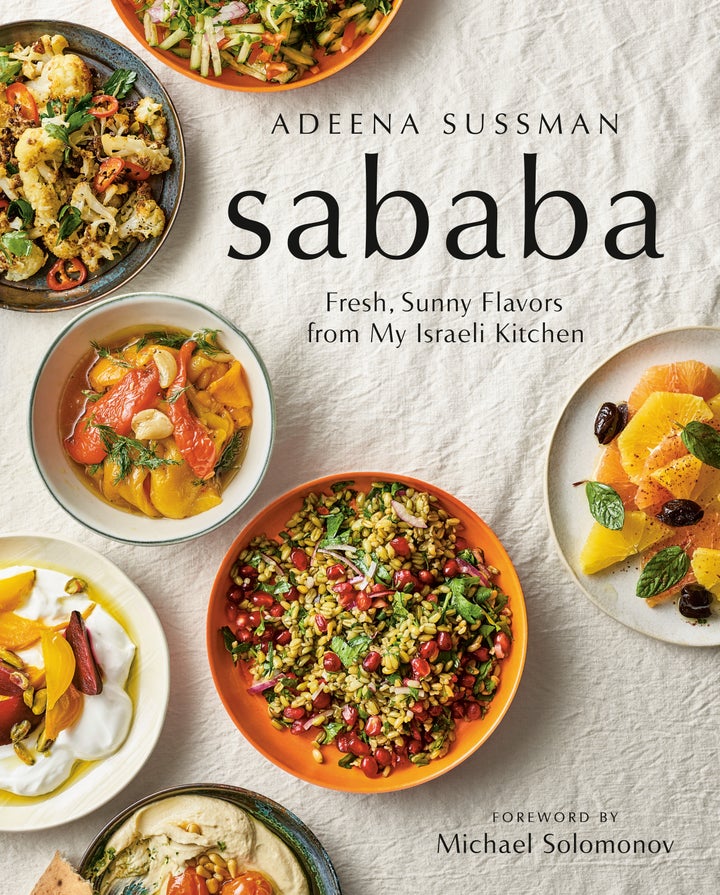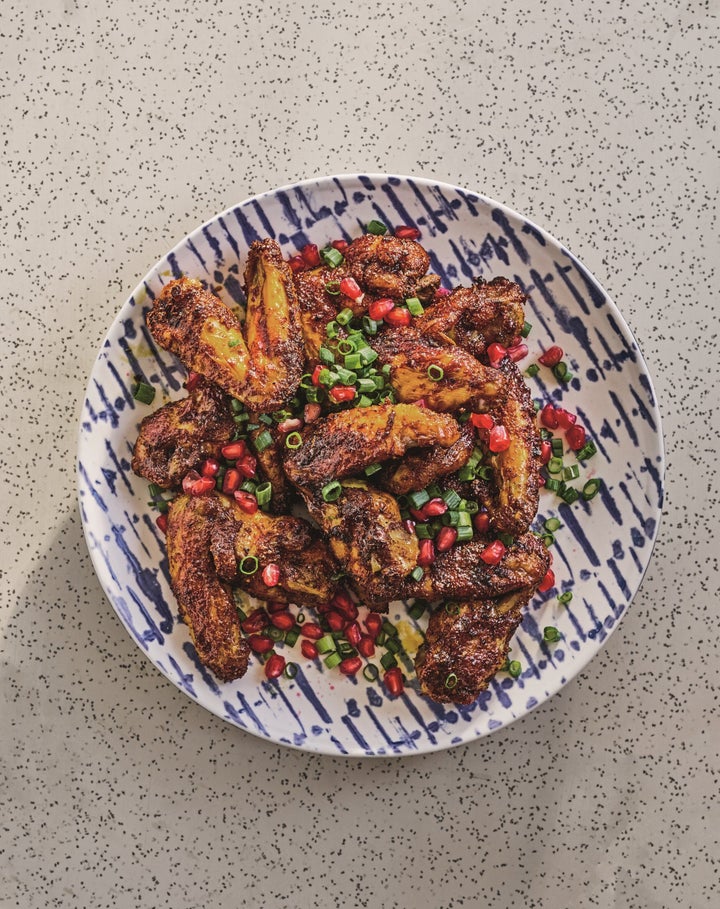Adeena Sussman is not employed by Israel’s office of tourism, but if you follow her Instagrammed culinary pursuits in Tel Aviv’s bustling food scene and in her home kitchen, you’ll immediately want to book a trip.
Read her new cookbook, “Sababa,” out Sept. 3, and you might just start frantically searching for the next available flight. At least that’s what I did.
“Sababa” (Arabic slang that translates to “everything is awesome”) is Sussman’s first solo cookbook. She has co-authored a wide range of books over her nearly 20-year career, perhaps the most recognizable being Chrissy Teigen’s popular “Cravings” and “Cravings: Hungry for More.”
But in “Sababa,” Sussman displays her passion for the flavors of the vibrant city for which she left New York. She made Tel Aviv her permanent home in 2015, coming to fully appreciate the bounty of fresh produce at Shuk HaCarmel, its famed open-air market.
Sussman is a fixture in the shuk most mornings. (“Although there is produce coming in throughout the day, most is coming in the morning hours, so I like to get first crack at stuff,” she told HuffPost over the phone last week.) It’s there that she does all of her shopping, greeting her usual vendors-turned-friends, all of whom she has spent years getting to know both in product and personally. In the foreword for “Sababa,” friend and fellow celebrity chef Michael Solomonov describes the shuk as “practically an ingredient in her cooking ― a style that prioritizes pristine produce and simplicity over luxury ingredients and fussiness.”
It’s true that from the looks of her cooking on social media, and from the music playing in the background as she whips up a salad, everything appears to be a pleasure ― leisurely, even. That, Sussman says, is true not only of Israeli food but of the general attitude surrounding dining and entertaining in Israel. It’s a vastly different approach than we have in the United States.
“I think allowing yourself to be inspired by the idea of Shabbat ― not about observing it but just the concept of preparing food in advance of the weekend to enjoy with family and friends ― also allows the host to enjoy themselves,” she said.
Sussman grew up observing Shabbat and said, although it’s a lot of work in advance, “once the weekend comes around it allows you to be part of the festivities as opposed to spending all your time in the kitchen.”
Having things prepped and available in advance comes in handy in a culture that, as Sussman says, is still very much about dropping by whenever, making time to connect spontaneously with no added pressure to be “ready” to host.
“I feel like in the U.S. we’ve gotten into this idea that everything has got to be perfect before you can allow people to come over, and in Israel, it’s just not like that,” she said. “You don’t have to have the immaculate home. You don’t have to have nine types of cheeses. People here still make time to have a pot of coffee with a friend, and I always make sure I have food in the fridge because people are coming by and expect something tasty if they stop by my house,” she added with a laugh.

When that happens, Sussman has a few things always on hand (many of which are recipes featured in her book) to put together in a pinch.
“I’ve always got stuff available to make cocktails,” she said. “Right now I have fresh limes and mangoes that can be blended into a drink. I always have some kind of dip or salad I’ve made and usually the makings of a quick salad. I always have some nut mix and some feta cheese, and a jar of lemony, mustardy olive oil dressing I make at the beginning of the week and use every night.”
At the heart of many of her dip and dressing recipes are a few ingredients that give the food its distinct, robust Middle Eastern flavor.
“We have here a lot of punchy things like schug (Yemeni hot sauce), harissa (chili pepper paste) and pomegranate molasses you can add to foods that feel very globe-trotting but also just feel very much of this place,” she said. “I think leaning heavily on condiments in another place or another time might seem like a cop-out, but these are really essential building blocks to the foods, so I use them liberally and as much as possible.”
There are recipes for all of these sauces in the book, but Sussman is quick to assure there are plenty of delicious store-bought versions, too.
“Something like preserved lemons, there are a lot of factors that go into it,” she said. “People who make them professionally, selecting the lemons with the thinnest skins, watching the process a little more carefully. New York Shuk makes a really good paste, which I think is a great staple instead of having to wait 60 to 90 days to have the lemons cure to make into the paste.” Sussman uses the paste to make a lemony pasta, which now we’re suddenly craving.
There’s also the matter of us not all being lucky enough to be within walking distance of produce paradise and halvah heaven, but Sussman’s tips for navigating and embracing the shuk, which she learned when she moved to Israel full time, can be applied to any open-air or farmers market.
“If you think about shopping in a shuk like being a kid in a new school, you don’t need to be friends with everyone, you just need to find your really good friends,” she said. “When I started, I would find the vendors who I thought were friendly, who had good product and were willing to spend time talking to me and sort of build relationships in the market. You don’t just start out buying everything from the farmers market. Let’s say you’re making something and want to buy eggplant, basil and tomatoes. Find the people who have the products that look good to you and spend time with that one person as opposed to trying to spread yourself thin.”
And about those eggplants that look easy but often end up as oily globs in our kitchens, Sussman has some tips for that, too.
“Try to buy eggplants that are younger and heavy for their size,” she said. “If they’re light, it means there’s a lot of air in them, and that’s just going to be a sponge for oil. It’s definitely a product I would buy from a farmers market if I could, because chances are it will be newer and fresher, and you can talk to the vendor about what you want to do with it.”
We have a long list of recipes we’re dying to try from “Sababa,” but we’ll start by sharing three of Sussman’s favorites: Roasted Tomatoes, Sour Lime Pomegranate Chicken Wings and Labaneh Yogurt Pops with a Tahini Magic Shell. Yes, you read right. A tahini. Magic. Shell.
Sussman’s outlook on cooking, culture, life — it’s all sababa to us.
Check out the recipes below. “Sababa” is available for pre-order now.
This interview has been edited for length and clarity.
Roasted Sheet Pan Cherry Tomatoes

In our house, we call the copious amount of cherry tomatoes, or agvaniot, we consume our “daily kilo,” and aside from snacking on them or throwing them into salads, this is what I do with them the most. An olive oil–splashed roast in a hot oven yields a kitchen staple with a thousand applications, whether as a topper for labaneh or a star turn in Roasted Tomato and Labaneh Pappardelle.
Makes 3 cups
Active Time: 5 minutes
Total Time: 25 minutes
2 pounds (6 cups) cherry tomatoes, rinsed and dried
2 tablespoons extra-virgin olive oil
1/2 teaspoon kosher salt, plus more to taste
1/4 teaspoon freshly ground black pepper
1. Preheat the oven to 425 degrees Fahrenheit.
2. Dump the tomatoes on a large rimmed baking sheet, drizzle with the olive oil, and sprinkle with the salt and pepper. Give the baking sheet a shake to coat the tomatoes. Roast until the tomatoes are shriveled and some of the juice releases onto the pan, 20 to 25 minutes (you don’t want to take these too far because then that juice will evaporate, and basically that juice adds the essence of tomato flavor straight from the heavens into anything it touches). Allow the tomatoes to cool, and make sure to scrape up and use the slightly jellied juices that collect on the pan.
Note: To use as a hummus topping: Spoon 1 cup of the finished roasted tomatoes and their juices over 2 cups prepared hummus of your choice. Top with toasted pine nuts and serve with Cardamom-Kissed Schug (from the book).
Sour Lime and Pomegranate Chicken Wings

Dried Persian limes ... come in two shades — black and a sort of walnut-y tan — and are traditionally dropped whole into Persian stews and soups to add a hint of citrus and the singular funk that only fermentation can. I wanted to spread the love to other preparations, so I crushed the limes into a powder to form the base for a dry rub that perfectly counter-balances the fattiness of chicken wings (you can also find dried lime powder on Amazon and Kalustyans.com). Sprinkling the rub on the wings, then letting it sink in, sends that distinctive pucker all the way down to the bone. I arrange the wings on a rack set over a baking dish and roast them until almost done, then brush them with pomegranate molasses for both high gloss and an extra layer of sour power.
Serves 6 to 8, as an appetizer
Active Time: 15 minutes
Total Time: 3 hours (including minimum marinating time)
1 teaspoon vegetable oil
2 pounds chicken wings (10 to 12 wings)
Juice and zest of 1 lime
4 small dried Persian limes, or 2 tablespoons Persian lime powder (known as lemon omani powder)
1 tablespoon ground turmeric
2 teaspoons garlic powder
2 teaspoons sweet paprika
2 teaspoons kosher salt, plus more for seasoning
2 teaspoons sugar
1 teaspoon onion powder
1 teaspoon freshly ground black pepper, plus more for seasoning
1 teaspoon ground cumin
1/3 cup pomegranate molasses (there’s a recipe in the book, or use store-bought)
Chopped scallion greens and pomegranate seeds, for serving
1. Line a large, rimmed baking sheet with foil, set a rack on top of the sheet, and grease the rack lightly with vegetable oil. In a large bowl, toss the wings with the lime juice and zest, then arrange them on the sheet, fleshy-side down, leaving space between each wing. Using the heel of a large chef’s knife, smash the Persian limes into a couple of pieces to break them up. In a spice grinder, pulverize them into a fine powder, 30 seconds. Add the turmeric, garlic powder, paprika, salt, sugar, onion powder, pepper and cumin, and pulse the grinder a few more times to create a unified mixture. Sprinkle half the mixture evenly over the wings, pressing it in gently with your hands. Flip the wings, then sprinkle and press in the other half of the mixture. If you have time, place the wings in the refrigerator for at least 2 hours and up to 24 hours (if you have room, leave them uncovered; this helps dry out the skin and crisp it up).
2. Preheat the oven to 400 degrees Fahrenheit.
3. Leaving the wings on the rack over the baking sheet, bake them until they’re sizzling and the meat is cooked, 40 to 45 minutes. Remove the wings from the oven, brush both sides with the pomegranate molasses, arrange the wings fleshy-side up on the rack, and return to the oven until the wings caramelize slightly, 5 to 6 minutes. Remove from the oven and season generously with salt and pepper.
4. To serve, transfer to a plate and sprinkle with the scallions and pomegranate seeds.
Note: If you can’t find dried Persian limes, using only fresh lime juice and zest works great, too. Simply toss the wings in the juice and zest of 2 limes as your first step, then combine all the other spices and proceed with the recipe.
Fig and Yogurt Pops with Tahini Magic Shell

Popsicles (known here as artikim) are a national obsession, delivering a refreshing blast chill when the temperatures spike from hot to hades. From the cheap, delicious, artificially flavored ices you can buy along the beach to Mexican-style paletas, which come in a million gourmet flavors, it’s easy to get a frozen/sweet fix on a stick. To show off the gorgeous fruit in season, I based these pops around thick, juicy slices of figs. I slide them into popsicle molds, then tip a tart, honey-sweetened yogurt mixture around them before freezing. If you can, try to arrange your pops so the figs remain visible (see instructions in recipe), but no matter how you build them, they’re delicious. The tahini magic shell really is two-ingredient heaven; dip once and you’ve got a semi-translucent sesame slick that hardens on contact with the pops; dip twice for a thicker layer. I make a generous amount of the magic shell because it makes dipping the pops easier; you can refrigerate any leftover shell, then gently rewarm it in the microwave. If you want to halve it, you’ll just have to tip and swirl the pops around to coat them.
Makes 4 pops
Active Time: 15 minutes
Total Time: 4 hours
Pops
1 cup plain yogurt
1/4 cup honey
Generous pinch of ground cardamom
Pinch of fine sea salt
2 or 3 large, plump fresh figs
Tahini Magic Shell
1 cup pure tahini paste
1/2 cup coconut oil, melted
Make and freeze the pops: In a medium bowl, whisk together the yogurt, honey, cardamom, and salt. Take a look at your popsicle molds and gauge how thick you need to slice your figs; you want to be able to slide the figs into the molds so they are fairly tightly wedged in place (this will mean you’ll see fig after they’re frozen). Slide 1 large or 2 smaller fig slices into the molds, then press a wooden popsicle stick through the figs down into the bottom of the molds. Pour the yogurt mixture around the figs, moving the figs slightly with your fingers and tapping the molds against the counter to allow the yogurt to fill any gaps and air pockets. Freeze until solid, 3 to 4 hours (or if you have an instant popsicle maker, by all means, use that).
Make the magic shell and finish the pops: Once the pops are frozen, combine the tahini and coconut oil until smooth in a glass that can fit the popsicle without it touching its sides. Line a plate with wax paper and place it in the freezer. Loosen the pops by letting them sit out for 5 minutes, or run the outside of the molds carefully under warm water in 15-second increments until they release. Dip each pop in the tahini mixture, pull it out, and let the excess mixture drip off. If desired, dip again; the mixture should harden almost immediately. Place each pop on the wax paper-lined plate as they’re done. Freeze for a few minutes before serving, or wrap each pop in wax paper, then in plastic wrap, and store in the freezer for up to 1 week.
Recipes reprinted from "Sababa" by arrangement with Avery, an imprint of Penguin Publishing Group, a division of Penguin Random House LLC. Copyright © 2019, Adeena Sussman.